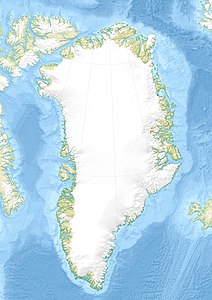Independence fjord
| Independence fjord | ||
|---|---|---|
|
MODIS satellite image of North Greenland with Independence Fjord |
||
| Waters | Independence fjord | |
| Land mass | Pearyland | |
| Geographical location | 82 ° 5 ′ N , 28 ° 34 ′ W | |
|
|
||
| width | approx. 30 km | |
| length | approx. 160 km | |
The Independence Fjord is a fjord in Northeast Greenland in today's Northeast Greenland National Park . It is approximately 160 km long and up to 30 km wide. Its mouth in the wall Elsee of the Arctic Ocean is at the position 82 ° 15 ' N , 021 ° 54' W . The Hagen Fjord , the Astrup Fjord and the Jørgen-Brønlund-Fjord flow into the Independence Fjord . Two large outlet glaciers of the Greenland Ice Sheet , the Marie-Sophie and the Akademie glaciers , calve directly into the fjord near its tip. They include the ice-free area of Vildtland , whose southeastern edge to the academy glacier is known as the Navy Cliff . Heilprin-Land and Melville-Land stretch on the north bank of the fjord, and Christensen Land on the south bank .
Traces of two Palaeoeskimo cultures have been found in the region around the fjord .
history
The more recent history of the Independence Fjord begins with its discovery and naming by the American Robert Peary , who first reached the area in 1892 with the Norwegian Eivind Astrup (1871–1895). The Danmark expedition led by Ludvig Mylius-Erichsen carried out a more precise mapping in 1907 . Christian Bendix Thostrup (1876–1945), a participant in this expedition, published the first comprehensive report in 1911 on the traces of human settlement found. Other major expeditions to the region were Knud Rasmussen First Thule Expedition 1912, the Danish Jubilee Expedition 1920-1923 with the circumnavigation Peary country by lye cooking and the Danish Peary land expedition from 1948 to 1949, by Eigil Knuth was headed .
prehistory
To the north of the fjord, in Pearyland , there are remains of the elliptical dwellings of the people from the Independence I culture . These people used stone and bone tools and made a living from hunting wild animals such as musk ox and arctic hare . Bones of musk ox found in Pearyland that were hunted by humans indicate a settlement around 2000 BC, the oldest finds are dated to 2400 BC. From around 1800 BC to 1300 BC, traces can still be found mainly in northeast Greenland, south of the fjord. It is unclear whether the Independence I culture perished or whether the people just emigrated.
Finds from about 500 years later, from around 800 BC to 200 BC, are assigned to the Independence II culture . Initially, Independence I and Independence II were viewed as one culture, but they could be separated from Eigil Knuth in 1956 due to different construction methods of the residential buildings and differences in other artifacts. For example, the houses of the Independence II culture are more complex and larger than the older buildings in this area. Unlike their predecessors, the people of the Independence II culture also settled areas south of the Independence Fjord.
In both cases it is unclear whether finds outside of the core distribution area in North Greenland and on Ellesmere Island should not be counted among other cultures. While the Independence I and Independence II cultures are counted among the pre-Dorset cultures , some of these finds are also assigned to the early Dorset culture . Some finds in North Greenland could also come from the Saqqaq culture (also pre-Dorset).
Web links
- National Museum: Independence I (English)
- National Museum: Independence II (English)
Individual evidence
- ↑ Sailing Directions (Enroute). Greenland and Iceland (PDF; 5.37 MB). Pub. 181, National Geospatial-Intelligence Agency, Springfield, Virginia 2010, p. 129
- ↑ Østgrønlandske Stednavne - Fra den første kortlægning (PDF; 9.54 MB) on the website of the Danish Arctic Institute (Danish)
- ↑ Christian Bendix Thostrup: Ethnographic Description of the Eskimo Settlements and Stone Remains in North-East Greenland . In: Meddelelser om Grønland XLIV, 1911, pp. 177-355.



